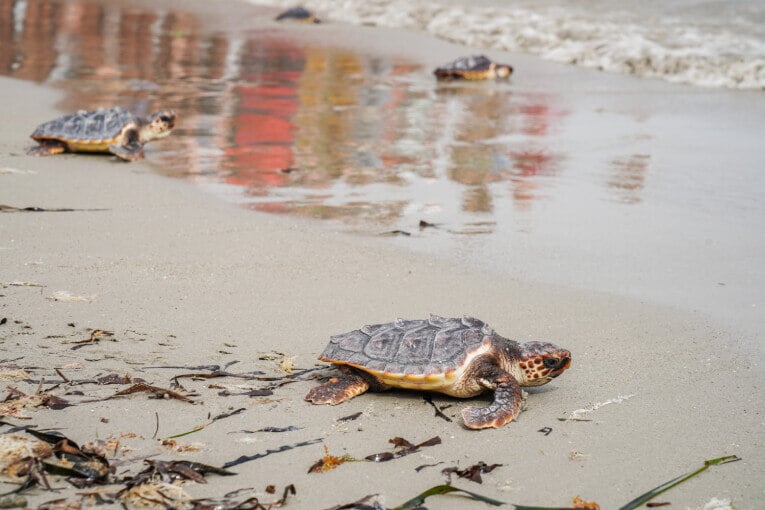If we tell you that last summer nine nests were found and almost 500 sea turtles hatched on Valencian beaches, what do you think? This is certainly unprecedented, but it is an indicator of the health of our marine ecosystem. The fact that they choose beaches like those of Valencia to lay their eggs is a sign that we have a real treasure on our coast.
This new role of Mediterranean beaches in the life cycle of sea turtles needs everyone's collaboration. It is not enough to have a quality coastline; there is much more to be done for them to survive.
We are going to tell you why they choose to nest here, why they are in danger of extinction, how to help them and how to fully enjoy the process if you find a nest or a sea turtle in Valencia.
Why do they choose Mediterranean waters to do so?
Sea turtles have quite complex migratory patterns, although they usually return and establish their nests on the beaches where they were born. Years ago there were hardly any traces of turtles around here, but now there are sea turtles in Valencia because its climate, between warm and hot, allows the incubation and hatching of the eggs to take place in optimal conditions.
But this is not the only reason for their choice. Valencian beaches have loose, warm sand and gentle slopes, ideal for them to easily dig deep nests far from the shore.
And why are they so important for the environment?
Sea turtles support the normal growth of seagrass and seagrass meadows, breeding grounds for many other species such as shrimp, lobster and tuna. They also feed on sponges and jellyfish, moderating their population development and preventing pests. Even the remains of their eggs and hatchlings - those that do not survive - are of great value; they decompose and enrich the wider coastal ecosystem.

The endless threats to sea turtles
There are many reasons that have brought these species to the point where they are today: threatened and on the verge of extinction.
It may seem that 500 turtles born in 2023 in the Valencian Community are a lot, but did you know that only one in every 1,000 turtles reaches adulthood? Most are killed on their way to the sea by predators such as crabs or accidentally by dogs or even humans.
But what has had the greatest impact is the invasion of plastics into the sea; 8 million tonnes end up there every year. They often mistake them for jellyfish and die from ingesting them or get caught in them.
Climate change is undoubtedly another factor that has had a major impact. They are very vulnerable to temperature change. So much so that, when they are born, sex is determined on this basis. Higher temperatures, more likely to give birth to females, tipping the balance further towards extinction.
But sea turtles are smart.
They can lay more than 150 eggs per nest and, if necessary, will lay several times each season to compensate for high mortality rates or low numbers of males.
They struggle to survive. Are you willing to help them?

How to help if you see a sea turtle in Valencia
If you are planning to visit any of the beautiful beaches of Valencia or, better still, spend a few days relaxing on them, open your eyes wide! Your collaboration is crucial to safeguard this endangered species.
Turtles tend to nest at night, so if you see signs of a nest, footprints in the sand or even a turtle on the beach, don't touch it!
Do not illuminate it either, and do not use flash photography. This could cause a failure to nest.
Ideally, you should call 112. They will be responsible for activating the protocol to ensure the safety of the eggs and the turtle.
In the meantime, keep a safe distance and enjoy the wonder of seeing a sea turtle in Valencia.
The work of the sea turtle conservation services in Valencia is outstanding
When you make that 112 call, you are being a key player in the conservation of the species. Within minutes, the conservation services are alerted and these professionals arrive at the nesting site in record time. It is a huge team of collaborators including the NGO Xaloc, the Oceanogràfic Foundation, the Department of the Environment, the Devesa-Albufera service, the El Saler Parador and the University of Valencia.

If they find the female in time, they attach a satellite transmitter to track her position and detect future nesting. They assess the situation and secure and demarcate the area, ensuring that the turtle is not disturbed during the whole process.
When the turtle has finished laying its eggs and returned to the sea, then comes the most difficult part: preserving the nest. It must be protected from accidental trampling, from umbrellas, from beach cleaning machinery and also from predators. This is usually done by placing nets or cages over it or, if it is too exposed, by relocating it.
And the work doesn't stop there, as they often guard the nest until hatching to ensure that the hatchlings reach the sea safely. Sometimes, some of the eggs are taken to ARCA, the Animal Recovery and Conservation Area of the Oceanográfic Foundation in Valencia, where they are carefully looked after until the turtles hatch, ensuring the survival of at least part of the nesting.

Well, you know, you are also key to saving this endangered species, being aware of its fragility and the responsibility we have to protect this species.
Keep your eyes peeled when you come to Valencia's beaches!


